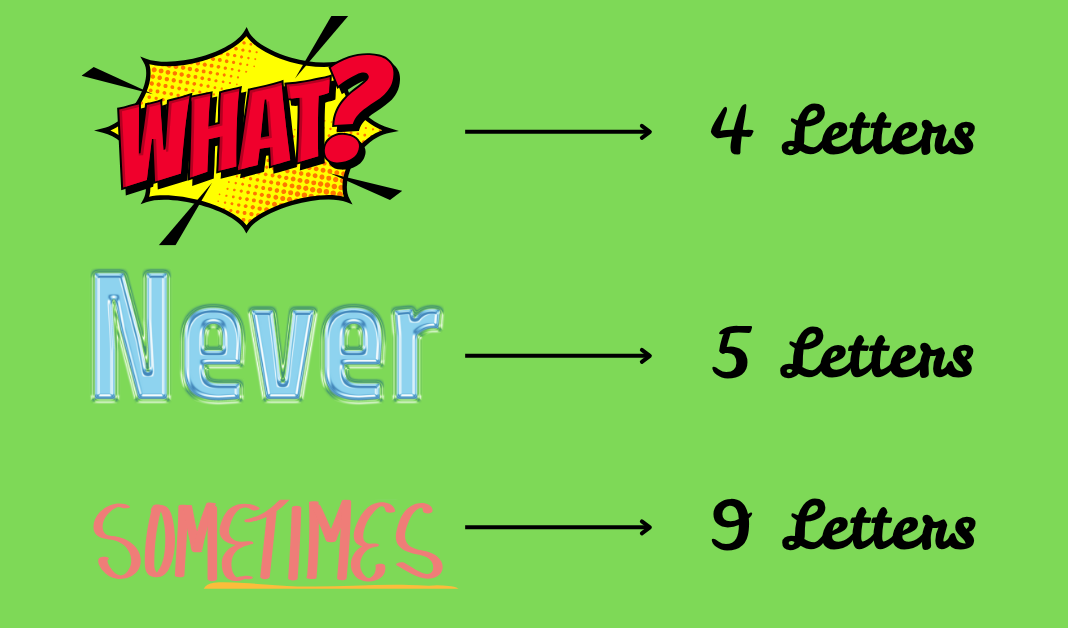When I first heard the phrase, “What has 4 letters, sometimes 9, but never 5,” I wondered what it really meant. I thought it was a riddle or a puzzle and even tried to decode it mathematically, assuming it had something to do with the number of letters in the words or some hidden logic
The truth is much simpler than most people expect. This statement isn’t really a riddle at all—it’s simply a play on words that’s been circulating online for years. In this article, I’ll break down what the phrase means, why it’s so widely misunderstood, and why it’s such a clever example of how language can trick our brains.
The Direct Answer
The phrase “What has 4 letters, sometimes 9, but never 5” is not asking a question. It is a literal statement:
- What is the name of a word, and it has 4 letters.
- Sometimes is another word, and it has 9 letters.
- Never is a word with 5 letters.
Once you see it broken down, it’s easy to understand. The confusion arises because we naturally try to interpret it as a question, when in fact it’s just describing the number of letters in each word.
Why Do People Think It’s a Riddle?
The way the phrase is structured tricks our brain into assuming it’s a question. When we read “What has 4 letters,” we automatically think we’re being asked “What word has 4 letters?” The same happens with “Sometimes 9” and “Never 5.”
This type of phrasing is an example of lexical ambiguity, where words or phrases can be interpreted in more than one way. Our brains are wired to seek patterns and meaning, so we immediately start looking for hidden answers when there are none.
How the Phrase Became Popular
The phrase has been around for years, but it gained new life thanks to social media and online forums. Users on platforms like Reddit and Twitter shared it as a joke, often to confuse others. Many people would spend hours trying to figure out the “answer” before someone finally pointed out the literal explanation.
Interestingly, the phrase is also used by teachers to illustrate how important context is when reading sentences. It shows how our assumptions can completely change the way we interpret language.
Real-Life Examples of Similar Wordplay
This isn’t the only phrase that uses language to trick us. Here are a few other examples:
- “Buffalo buffalo Buffalo buffalo buffalo buffalo Buffalo buffalo.”
This is a grammatically correct sentence using the word “buffalo” in different forms (noun, verb, and proper noun). - “Time flies like an arrow; fruit flies like a banana.”
The first part is literal, while the second uses “flies” and “like” in a different way, changing the meaning entirely. - “I saw her duck.”
This can mean you saw the bird (her duck) or that you saw her lower her head (to duck).
These examples, like the original phrase, rely on ambiguity to create confusion or humor.
Why Language Tricks Like This Fascinate Us
Phrases like “What has 4 letters, sometimes 9, but never 5” are interesting because they expose how our brains process language. We don’t just read words—we interpret them based on expectations and context.
I remember the first time I saw this phrase online. I stared at it for several minutes, convinced it was a clever riddle I just couldn’t solve. Only later did someone explain the simple truth. It was both frustrating and funny, and I realized how easily I had overcomplicated it.
This type of wordplay also reminds us that communication isn’t just about words. It’s about how we understand them. Even a small shift in context can completely change the meaning.
Can This Phrase Be Used as a Teaching Tool?
Absolutely. Teachers and writers often use the phrase as a way to explain ambiguity and literal meaning. It’s a simple example that students can easily remember.
For instance, an English teacher might write it on the board and ask the class to interpret it. Some students will try to solve it as a riddle, while others may recognize the literal explanation. The exercise can lead to a discussion about how punctuation and sentence structure affect meaning.
A Fun Way to Share It
If you want to share this phrase with friends or on social media, try not giving away the answer right away. Post it as is and see how people react. Most will immediately think it’s a riddle and start brainstorming complex solutions. When you reveal the real explanation, it usually gets a laugh.
You can also add punctuation to make the meaning clearer, like this:
“What has 4 letters. Sometimes has 9. But Never has 5.”
By breaking it into separate sentences, you make it obvious that each part is a statement, not a question.
Final Thoughts
The phrase “What has 4 letters, sometimes 9, but never 5” is a clever example of how language can trick us. It’s not a puzzle to be solved, but rather a playful statement about the number of letters in three different words.
Next time you see it online, you’ll know the answer—and you can pass along the explanation to others who might be scratching their heads.
If you found this article informative, feel free to check out our other articles as well.










